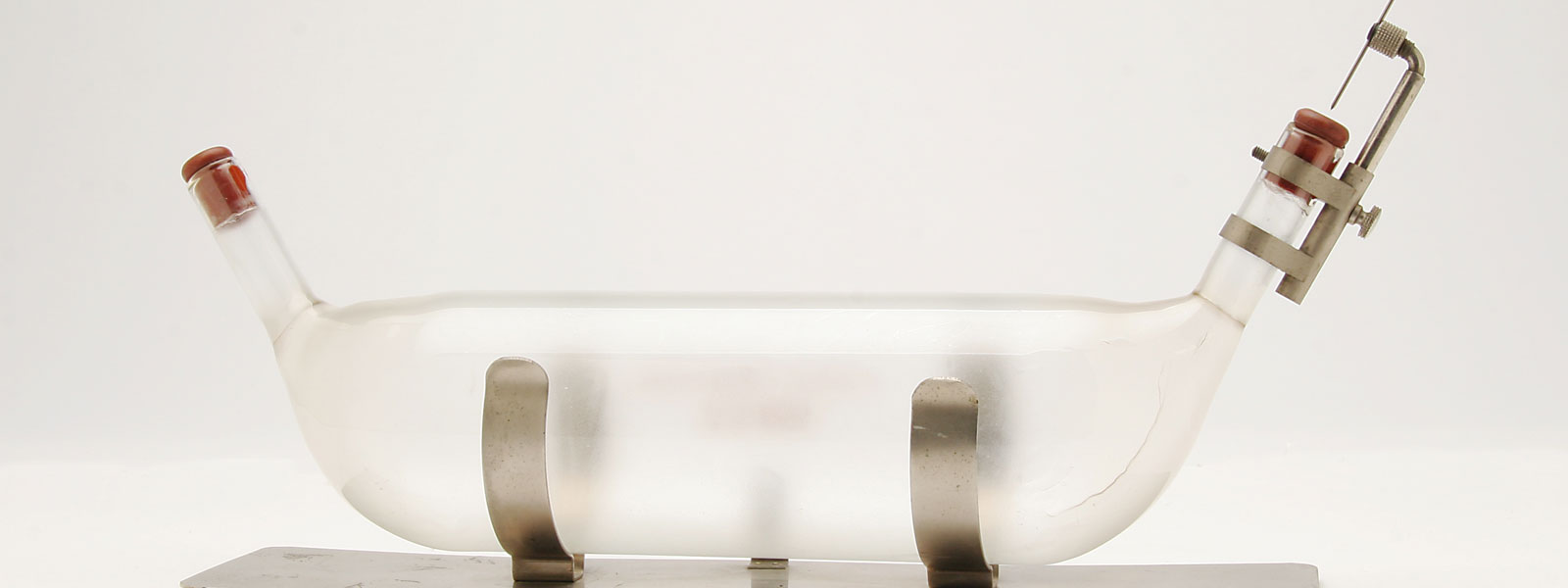Transfusion flebula
Transfusing under sterile conditions
Technical file
Type of innovation: Instrument
Scope: Hemotherapy
Innovation leader: Grifols i Roig, Josep Antoni
Year: 1928
Period: 1909-1971
Geographical scope: Spain
Economic impact: Low
Level of innovation: Disruptive
Patent: Yes
Interdisciplinary connections: -
The battles of the First World War gave a massive impetus to the field of blood transfusions. At the time, there were many technical difficulties to overcome to make this the practical, safe and widespread practice it is today.
“It was the first instrument invented in Spain based on the technique of indirect transfusion.”
The challenges of indirect transfusion
Not least of the challenges was the problem of indirect transfusions. Early blood transfusions were direct: in other words, arm-to-arm transfusions done with both donor and recipient lying side by side, in the same room, at the same time.
Indirect transfusion, where donations are made, the blood stored, and later transfused into a patient, was clearly a more practical solution. Achieving it without the risk of infection or contamination was the goal of several researchers, including Dr. Grifols i Roig.
His instrument, named the transflecor flébula was presented at the Real Academia de Medicina de Barcelona on May 23, 1928. This device was patented in Spain and Germany that same year, in France and Great Britain a year later, and in the United States in 1933. It was the first instrument invented in Spain based on the technique of indirect transfusion.
Reducing risks for patients
The transflecor flébula was similar to an existing invention, named the Kimpton-Brown-Percy tube. The Grifols innovation was to reduce the contact surface area and dispense with rubber tubes or valves, increasing the probability that the donated blood would remain aseptic, and free from contamination.
Another innovation was the use of sodium citrate to prevent the blood from clotting. The use of this compound dates back to 1914 when different researchers around the world discovered its efficacy as an anti-clotting agent.
Although not a huge commercial success due to its relatively high cost of manufacture, the transflecor flébula was a key contribution to shaping the new medical discipline of hemotherapy.

Bibliography
Grifols-Roig, J. A. (1928). Bluttransfusionsapparat. Patente alemana de invención, no. 569.648. Berlin: Reichspatentamt Patentschrift.
Grifols-Roig, J. A. (1929). Dispositif pour injections ou prélevements de sang. Patente francesa de invención, no. 671.969. Paris: Vrevet d'invention Délivré Sans Garantie du Gouvernement.
Grifols-Roig, J. A. (1929). Needle Holder for Ampules. Patente inglesa de invención, no. 308.597 London: Patent Specification of his Majesty's Stationery Office.
Grifols-Roig, J. A. (1933). Blood transfusion apparatus. Patente americana de invención, no. 1.923.846. Washington: United States Patent Office.
Grifols-Roig, J.A. (1933). La transfusió de sang citratada per mitjà de la flèbula transfusora. Annals de l'Hospital Comarcal de Vilafranca del Penedès, 49-65.
Grifols-Roig, J.A. (1934). Tècnica actual i probablement definitiva de la transfusió sanguínia per mitjà de la Flèbula transfusora. Annals de Medicina, 4, 712-714.
Peset Llorca, V. (1943). La transfusión de sangre (biología y técnica). Barcelona: Editorial Científico Médica.
Machetti Croso, S. (1952). Epítome de Transfusión Sanguínea. Zaragoza: Artes gráficas Pirineos.
Schneider, W.H. (2003). Blood transfusion between the wars. Journal of the History of Medicine and Allied Sciences, 58(2), 187-224.
Grifols-Lucas, V. (2009). Amb un suro i un cordill. Vivències d'un empresari de postguerra. Barcelona: Grupo Grifols, S.A.
Avellà, R., & Miquel, B. (Eds.). (2015). Cuando un sueño se cumple. Crónica ilustrada de 75 años de Grifols. Barcelona: Grupo Grifols S.A.
Baños, J.E., & Guardiola, E. (2017). Eponímia mèdica catalana. Les flèbules de Grífols. Annals de Medicina, 100(2), 87-90.
Related innovations
PROCEDURE
Indirect transfusion
INSTRUMENT
Analysis flebula with elastic stopper
REAGENT
Control sera and the ABO blood typing system